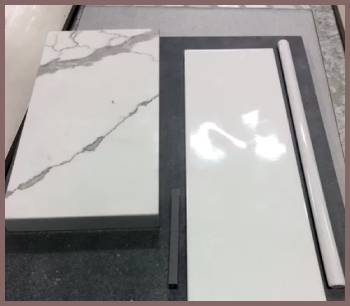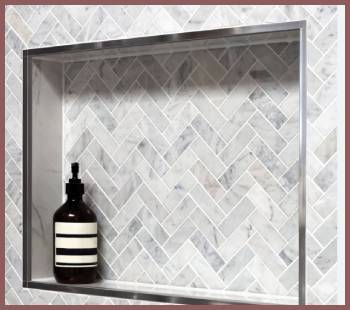When it comes to the world of tile installation and design, the choices are endless. And one of the most critical decisions is choosing the right trim for your tiles.
In this article, we will be comparing two popular options – Pencil Tile and Schluter – and exploring their pros and cons to help you make the right choice for your project.
A Brief Comparison Table
| Comparison Aspect | Pencil Tile | Schluter |
| Materials | Ceramic, porcelain, natural stone | Metal, PVC |
| Aesthetic Appeal | Elegant, sophisticated | Clean, professional |
| Edge Protection | Limited | Excellent |
| Variety | Wide range of materials, colors, and finishes | Wide range of styles and finishes |
| Installation | Easy | More complex, may require expertise |
| Maintenance | Varies by material, can be higher | Low maintenance |
| Durability | Varies by material | Long-lasting performance |
| Cost | Typically more affordable | Can be more expensive, especially for metal |
The Tale of Two Trims: What Are Pencil Tile and Schluter?
Before diving into the advantages and disadvantages of each option, let’s first get a clear understanding of what Pencil Tile and Schluter are.
Pencil Tile

Pencil Tile, as the name suggests, is a slim and elongated tile that is typically used as a decorative edge or border for various tile installations. Made from materials like ceramic, porcelain, or natural stone, pencil tile adds a touch of elegance and refinement to the edges of your tile work, providing a seamless transition between different surfaces.
Schluter
Schluter, on the other hand, is a brand name that has become synonymous with its signature product – the Schluter tile edge trim. Made from metal or PVC, Schluter trim profiles are designed to protect and finish the edges of tiled surfaces, preventing damage and providing a clean, professional appearance.
They come in various styles and finishes, making them a versatile option for all kinds of tile installations.
Pros and Cons: Pencil Tile and Schluter Head-to-Head
Now that we know what Pencil Tile and Schluter are, let’s take a closer look at their pros and cons to help you make an informed decision for your project.
Pencil Tile: Pros and Cons
Pros
- Aesthetic Appeal
Pencil Tile adds a touch of elegance and sophistication to your tile installation, enhancing the overall design and visual appeal.
- Variety
Pencil Tile is available in various materials, colors, and finishes, giving you more design options and allowing you to match it perfectly with your existing tilework.
- Easy Installation
Pencil Tile is relatively easy to install, making it an accessible choice even for DIY enthusiasts.
Cons
- Limited Edge Protection
Pencil Tile provides a decorative border but offers limited protection to the edges of your tiles, making them more susceptible to damage.
- Higher Maintenance
Some materials used for Pencil Tile, like natural stone, may require more maintenance and care compared to other options.
Schluter: Pros and Cons

Pros
- Edge Protection
Schluter trim profiles offer excellent edge protection, safeguarding your tiles from chipping and damage.
- Clean, Professional Appearance
Schluter provides a clean, professional finish to your tile installation, ensuring a polished and seamless look.
- Wide Range of Styles and Finishes
Schluter is available in various styles and finishes, making it easy to find the perfect match for your tilework.
- Durable
Schluter trim profiles are made from durable materials like metal or PVC, ensuring long-lasting performance and minimal maintenance.
Cons
- Cost
Schluter can be more expensive than other trim options, especially when considering the high-quality metal profiles.
- Installation Complexity
Schluter may require more expertise and skill to install compared to simpler options like Pencil Tile.
FAQ: Answering Your Most Pressing Questions
If you’re looking for alternatives to Schluter, you can consider options like Pencil Tile, bullnose tile, or other decorative trims made from materials like ceramic, porcelain, or natural stone. These options may offer varying levels of edge protection and design versatility, so choose based on your specific needs and preferences.
Pencil tile serves as a decorative border or edge for various tile installations, enhancing the overall aesthetic appeal of your project. It helps create a seamless transition between different surfaces and adds a touch of elegance and sophistication to the design.
The choice between Schluter and bullnose tile depends on your specific requirements and preferences. Schluter offers excellent edge protection and a clean, professional finish, while bullnose tile provides a rounded, continuous edge that can complement your tilework. Consider factors like design, durability, and installation complexity when making your decision.
Pencil tile trim can be used in various applications, including:
As a decorative border or edge for wall and floor tile installations, such as backsplashes, shower walls, and kitchen floors.
To create a transition between different surfaces or materials, like tiles and wallpaper or painted walls.
As an accent or design element in combination with other tile patterns and styles.
Schluter can be a worthwhile investment for your tile installation, as it offers excellent edge protection, durability, and a clean, professional appearance. While it may be more expensive than some other trim options, the long-lasting performance and minimal maintenance make it a cost-effective choice in the long run.
If you prefer not to use Schluter, you can finish your tile edge using alternatives like:
Pencil Tile: A slim, decorative trim that adds elegance and refinement to your edges.
Bullnose Tile: A rounded, continuous edge that can complement your tilework.
Ceramic or Stone Trims: Decorative trims made from materials like ceramic, porcelain, or natural stone, which can offer varying levels of edge protection and design versatility.
Grout: In some cases, you can use grout to create a clean edge for your tiles, although this may not provide the same level of protection and durability as other options.
Final Thoughts: Making the Right Choice for Your Project
When it comes to choosing between Pencil Tile and Schluter for your tile installation, there’s no one-size-fits-all answer. Both options have their pros and cons, and the best choice will depend on your specific requirements, preferences, and budget.
If you prioritize design and aesthetic appeal, Pencil Tile may be the ideal option for you. However, if you value durability and edge protection, Schluter is worth considering. Ultimately, take the time to assess your needs and explore the available options, ensuring that you make the right decision for your project.




